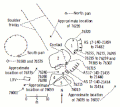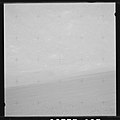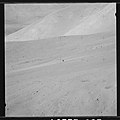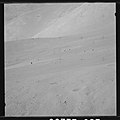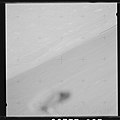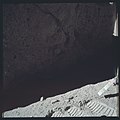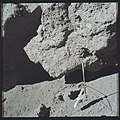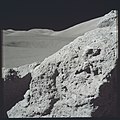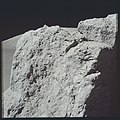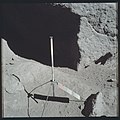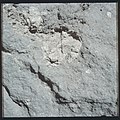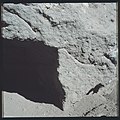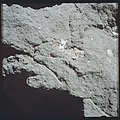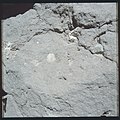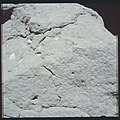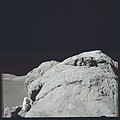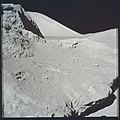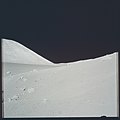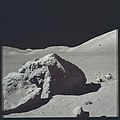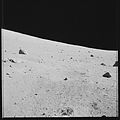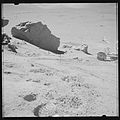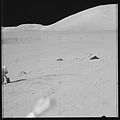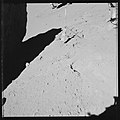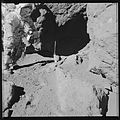Category:Apollo 17 EVA at Station 6
From the Apollo 17 Preliminary Science Report, Chapter 5 (NASA SP-330, 1973):
The North Massif
The North and South Massifs form the majestic walls of the Taurus-Littrow valley and rise to heights of 2000 and 2300 m, respectively, above the valley floor, with flanking slopes of approximately 25°. The massifs represent the major structural boundaries of the valley. Their faces contain intermittent exposures of thick sections of pre-mare crustal rocks. Numerous fields, or "source-crops," of boulders are present on the upper one-half to two-thirds of the slopes of both massifs. Boulder tracks indicate that blocks have rolled into the valley from these sources. Several of these blocks were the prime field objectives of our traverses in the Taurus-Littrow valley.
The source-crops for the boulders on the slopes of the North Massif are linear but discontinuous. They are roughly horizontal in apparent orientation, and each is a few hundred meters in length. The large boulder investigated at station 6 has a well-defined track above it and appears to have originated from the lowermost source-crop band approximately one-third of the way up the slope.
Based on what had been seen on previous lunar missions, the geologic complexity of the boulders at stations 6 and 7 was unexpected. Here, for the first time, it was possible to observe and sample across a major lithologic and structural contact. This contact was exposed sharply in boulders large enough that outcrop investigative techniques could be applied. As always, however, time was relentless and many questions were only partially answered. Still, much was learned.
Three major categories of stratigraphic materials were studied and sampled in the boulders at stations 6 and 7. A younger, finely crystalline, strikingly vesicular, tan-gray, matrix-rich breccia. The clasts also appear deformed and partially mixed with blue-gray material in the station 6 boulders. The distinctive clasts are apparently the oldest stratigraphic materials sampled at the Taurus-Littrow site.
Scattered, distinctive , light-colored clasts also are present in the tan-gray breccia; however, the stratigraphic relations of these clasts to either the blue-gray breccia or its included clasts were not apparent.
A marked brown patina is well developed on all weathered rock surfaces in the Taurus-Littrow valley. The patina is most prominent on the surfaces of the massif breccias, including the fractured surfaces of the blocks with well-preserved boulder tracks above them at station 6.
The light-gray walls of craters on the slopes of the North Massif and light-gray material we uncovered with our boots suggest that this type of fine debris, mixed with boulders, forms the bulk of the talus at the base of the massif. Fillets of this material are largely absent around boulders except on some uphill sides. Overlying the light-gray fine-grained talus is a medium-gray surface material that is generally a few centimeters thick. Unlike the filleted boulders of the valley floor, the sides of boulders commonly overhang this surface material.
Media in category "Apollo 17 EVA at Station 6"
The following 200 files are in this category, out of 215 total.
(previous page) (next page)-
A17 PSR Figure 6-116 Station 6.gif 349 × 310; 20 KB
-
Apollo 17 lunar rover AS17-146-22296HR.jpg 3,000 × 3,000; 1.6 MB
-
AS17-139-21186 (21672756072).jpg 4,175 × 4,175; 4.67 MB
-
AS17-139-21187 (21684177255).jpg 4,175 × 4,175; 4.32 MB
-
AS17-139-21188 (21496250590).jpg 4,175 × 4,175; 4.35 MB
-
AS17-139-21189 (21693357591).jpg 4,175 × 4,175; 4.46 MB
-
AS17-139-21190 (21496250440).jpg 4,175 × 4,175; 4.45 MB
-
AS17-139-21191 (21496345218).jpg 4,175 × 4,175; 4.41 MB
-
AS17-139-21192 (21672755042).jpg 4,175 × 4,175; 4.43 MB
-
AS17-139-21193 (21063192943).jpg 4,175 × 4,175; 4.47 MB
-
AS17-139-21194 (21063192813).jpg 4,175 × 4,175; 4.48 MB
-
AS17-139-21195 (21684154705).jpg 4,175 × 4,175; 4.36 MB
-
AS17-139-21196 (21684176325).jpg 4,175 × 4,175; 4.48 MB
-
AS17-139-21197 (21693379051).jpg 4,175 × 4,175; 4.47 MB
-
AS17-139-21198 (21497357209).jpg 4,175 × 4,175; 4.37 MB
-
AS17-139-21199 (21496227760).jpg 4,175 × 4,175; 4.48 MB
-
AS17-139-21200 (21496249060).jpg 4,175 × 4,175; 4.48 MB
-
AS17-139-21201 (21684175645).jpg 4,175 × 4,175; 4.41 MB
-
AS17-139-21202 (21063192013).jpg 4,175 × 4,175; 4.42 MB
-
AS17-139-21203 (21496343668).jpg 4,175 × 4,175; 4.36 MB
-
AS17-139-21204 (21693378331).jpg 4,175 × 4,175; 4.6 MB
-
AS17-139-21205 (21496322168).jpg 4,175 × 4,175; 4.46 MB
-
AS17-139-21206 (21658113896).jpg 4,175 × 4,175; 4.73 MB
-
AS17-139-21207 (21063191493).jpg 4,175 × 4,175; 4.47 MB
-
AS17-139-21208 (21063191343).jpg 4,175 × 4,175; 4.46 MB
-
AS17-139-21209 (21061494494).jpg 4,175 × 4,175; 4.28 MB
-
AS17-139-21210 (21672753002).jpg 4,175 × 4,175; 4.33 MB
-
AS17-139-21211 (21672733472).jpg 4,175 × 4,175; 4.52 MB
-
AS17-140-21400 (21672821122).jpg 4,175 × 4,175; 5.1 MB
-
AS17-140-21401 (21497424259).jpg 4,175 × 4,175; 8.8 MB
-
AS17-140-21402 (21684241705).jpg 4,175 × 4,175; 10.13 MB
-
AS17-140-21403 (21658179676).jpg 4,175 × 4,175; 9.77 MB
-
AS17-140-21404 (21061561314).jpg 4,175 × 4,175; 10.37 MB
-
AS17-140-21405 (21497422709).jpg 4,175 × 4,175; 8.66 MB
-
AS17-140-21406 (21693419641).jpg 4,175 × 4,175; 8.95 MB
-
AS17-140-21407 (21693442891).jpg 4,175 × 4,175; 10.14 MB
-
AS17-140-21408 (21693442111).jpg 4,175 × 4,175; 10.53 MB
-
AS17-140-21409 (21658177316).jpg 4,175 × 4,175; 6.97 MB
-
AS17-140-21410 (21684238215).jpg 4,175 × 4,175; 8.82 MB
-
AS17-140-21411 (21658176496).jpg 4,175 × 4,175; 7.49 MB
-
AS17-140-21412 (21063253623).jpg 4,175 × 4,175; 7.44 MB
-
AS17-140-21413 (21061558184).jpg 4,175 × 4,175; 7.93 MB
-
AS17-140-21414 (21063253103).jpg 4,175 × 4,175; 9.15 MB
-
AS17-140-21415 (21497418889).jpg 4,175 × 4,175; 9.21 MB
-
AS17-140-21416 (21693439391).jpg 4,175 × 4,175; 7.73 MB
-
AS17-140-21417 (21496405668).jpg 4,175 × 4,175; 10.17 MB
-
AS17-140-21418 (21061556784).jpg 4,175 × 4,175; 10.89 MB
-
AS17-140-21419 (21496291340).jpg 4,175 × 4,175; 10.86 MB
-
AS17-140-21420 (21496404998).jpg 4,175 × 4,175; 9.08 MB
-
AS17-140-21421 (21061556254).jpg 4,175 × 4,175; 9.27 MB
-
AS17-140-21422 (21497417109).jpg 4,175 × 4,175; 8.61 MB
-
AS17-140-21423 (21497416909).jpg 4,175 × 4,175; 8.56 MB
-
AS17-140-21424 (21063250683).jpg 4,175 × 4,175; 8.87 MB
-
AS17-140-21425 (21496309090).jpg 4,175 × 4,175; 8.46 MB
-
AS17-140-21426 (21496403558).jpg 4,175 × 4,175; 8.51 MB
-
AS17-140-21427 (21693418901).jpg 4,175 × 4,175; 8.54 MB
-
AS17-140-21428 (21693436951).jpg 4,175 × 4,175; 6.88 MB
-
AS17-140-21429 (21496403248).jpg 4,175 × 4,175; 7.91 MB
-
AS17-140-21430 (21693436351).jpg 4,175 × 4,175; 9.19 MB
-
AS17-140-21431 (21061554164).jpg 4,175 × 4,175; 7.35 MB
-
AS17-140-21432 (21693435881).jpg 4,175 × 4,175; 8.93 MB
-
AS17-140-21433 (21693435471).jpg 4,175 × 4,175; 6.87 MB
-
AS17-140-21434 (21497397899).jpg 4,175 × 4,175; 7.48 MB
-
AS17-140-21435 (21672811472).jpg 4,175 × 4,175; 6.36 MB
-
AS17-140-21436 (21497414409).jpg 4,175 × 4,175; 7.8 MB
-
AS17-140-21437 (21672811122).jpg 4,175 × 4,175; 6.05 MB
-
AS17-140-21438 (21496401258).jpg 4,175 × 4,175; 6.97 MB
-
AS17-140-21439 (21658170036).jpg 4,175 × 4,175; 6.5 MB
-
AS17-140-21440 (21672810452).jpg 4,175 × 4,175; 7.11 MB
-
AS17-140-21441 (21497397689).jpg 4,175 × 4,175; 7.88 MB
-
AS17-140-21442 (21658169696).jpg 4,175 × 4,175; 8.22 MB
-
AS17-140-21443 (21497413189).jpg 4,175 × 4,175; 7.33 MB
-
AS17-140-21444 (21658169066).jpg 4,175 × 4,175; 5.89 MB
-
AS17-140-21445 (21496399998).jpg 4,175 × 4,175; 5.52 MB
-
AS17-140-21446 (21061535884).jpg 4,175 × 4,175; 5.48 MB
-
AS17-140-21447 (21497412709).jpg 4,175 × 4,175; 5.59 MB
-
AS17-140-21448 (21496304560).jpg 4,175 × 4,175; 6.04 MB
-
AS17-140-21449 (21063246143).jpg 4,175 × 4,175; 6 MB
-
AS17-140-21450 (21496399168).jpg 4,175 × 4,175; 7.68 MB
-
AS17-140-21451 (21497411459).jpg 4,175 × 4,175; 7.37 MB
-
AS17-140-21452 (21672808142).jpg 4,175 × 4,175; 6.45 MB
-
AS17-140-21453 (21063245193).jpg 4,175 × 4,175; 6.3 MB
-
AS17-140-21454 (21061535784).jpg 4,175 × 4,175; 7.43 MB
-
AS17-140-21455 (21061549694).jpg 4,175 × 4,175; 5.78 MB
-
AS17-140-21456 (21496398258).jpg 4,175 × 4,175; 5.83 MB
-
AS17-140-21457 (21658167016).jpg 4,175 × 4,175; 6.5 MB
-
AS17-140-21458 (21684228185).jpg 4,175 × 4,175; 6.49 MB
-
AS17-140-21459 (21672806952).jpg 4,175 × 4,175; 6.69 MB
-
AS17-140-21460 (21693417871).jpg 4,175 × 4,175; 6.24 MB
-
AS17-140-21461 (21497410079).jpg 4,175 × 4,175; 6.65 MB
-
AS17-140-21462 (21496397378).jpg 4,175 × 4,175; 7.62 MB
-
AS17-140-21463 (21672806272).jpg 4,175 × 4,175; 6.18 MB
-
AS17-140-21464 (21684227065).jpg 4,175 × 4,175; 8.56 MB
-
AS17-140-21465 (21497409009).jpg 4,175 × 4,175; 6.6 MB
-
AS17-140-21466 (21684226415).jpg 4,175 × 4,175; 8.02 MB
-
AS17-140-21467 (21658164676).jpg 4,175 × 4,175; 5.77 MB
-
AS17-140-21468 (21693429121).jpg 4,175 × 4,175; 8.25 MB
-
AS17-140-21469 (21672804752).jpg 4,175 × 4,175; 5.89 MB
-
AS17-140-21470 (21496289750).jpg 4,175 × 4,175; 8.96 MB
-
AS17-140-21471 (21658164166).jpg 4,175 × 4,175; 5.91 MB
-
AS17-140-21472 (21061546494).jpg 4,175 × 4,175; 9.11 MB
-
AS17-140-21473 (21672804102).jpg 4,175 × 4,175; 5.89 MB
-
AS17-140-21474 (21693427991).jpg 4,175 × 4,175; 7.2 MB
-
AS17-140-21475 (21672803732).jpg 4,175 × 4,175; 8.88 MB
-
AS17-140-21476 (21684224385).jpg 4,175 × 4,175; 9.13 MB
-
AS17-140-21477 (21658153016).jpg 4,175 × 4,175; 7.13 MB
-
AS17-140-21478 (21497406099).jpg 4,175 × 4,175; 6.07 MB
-
AS17-140-21479 (21658162256).jpg 4,175 × 4,175; 6.15 MB
-
AS17-140-21480 (21658162016).jpg 4,175 × 4,175; 6.38 MB
-
AS17-140-21481 (21497405459).jpg 4,175 × 4,175; 6.64 MB
-
AS17-140-21482 (21658161796).jpg 4,175 × 4,175; 7.14 MB
-
AS17-140-21483 (21658161646).jpg 4,175 × 4,175; 5.91 MB
-
AS17-140-21484 (21496297330).jpg 4,175 × 4,175; 8.25 MB
-
AS17-140-21485 (21658152946).jpg 4,175 × 4,175; 8.57 MB
-
AS17-140-21486 (21672801662).jpg 4,175 × 4,175; 7.91 MB
-
AS17-140-21487 (21684222715).jpg 4,175 × 4,175; 6.13 MB
-
AS17-140-21488 (21496296820).jpg 4,175 × 4,175; 8.99 MB
-
AS17-140-21489 (21063237963).jpg 4,175 × 4,175; 9.33 MB
-
AS17-140-21490 (21496390898).jpg 4,175 × 4,175; 8.38 MB
-
AS17-140-21491 (21684221925).jpg 4,175 × 4,175; 7.85 MB
-
AS17-140-21492 (21658159976).jpg 4,175 × 4,175; 7.71 MB
-
AS17-140-21493 (21693424061).jpg 4,175 × 4,175; 9.03 MB
-
AS17-140-21493+AS17-140-21497.jpg 5,334 × 2,992; 4.19 MB
-
AS17-140-21494 (21496383078).jpg 4,175 × 4,175; 9.35 MB
-
AS17-140-21495 (21063236643).jpg 4,175 × 4,175; 9.22 MB
-
AS17-140-21496 (21061541354).jpg 4,175 × 4,175; 9.18 MB
-
AS17-140-21497 (21496389518).jpg 4,175 × 4,175; 8.7 MB
-
AS17-140-21498 (21497402519).jpg 4,175 × 4,175; 7.97 MB
-
AS17-140-21499 (21684220075).jpg 4,175 × 4,175; 6.69 MB
-
AS17-140-21500 (21672793492).jpg 4,175 × 4,175; 5.97 MB
-
AS17-140-21501 (21684219775).jpg 4,175 × 4,175; 5.37 MB
-
AS17-140-21502 (21496294200).jpg 4,175 × 4,175; 5.19 MB
-
AS17-140-21503 (21061539984).jpg 4,175 × 4,175; 5.47 MB
-
AS17-140-21504 (21496293940).jpg 4,175 × 4,175; 5.63 MB
-
AS17-140-21505 (21693422011).jpg 4,175 × 4,175; 6.06 MB
-
AS17-140-21506 (21684214195).jpg 4,175 × 4,175; 6.46 MB
-
AS17-140-21507 (21497401259).jpg 4,175 × 4,175; 7.52 MB
-
AS17-140-21508 (21061539234).jpg 4,175 × 4,175; 8.7 MB
-
AS17-140-21509 (21063234253).jpg 4,175 × 4,175; 5.57 MB
-
AS17-141-21575 (21056927874).jpg 4,175 × 4,175; 4.48 MB
-
AS17-141-21576 (21056926444).jpg 4,175 × 4,175; 4.65 MB
-
AS17-141-21577 (21688801951).jpg 4,175 × 4,175; 4.53 MB
-
AS17-141-21578 (21056923564).jpg 4,175 × 4,175; 4.57 MB
-
AS17-141-21579 (21058612113).jpg 4,175 × 4,175; 4.52 MB
-
AS17-141-21580 (21058610503).jpg 4,175 × 4,175; 4.6 MB
-
AS17-141-21581 (21679583675).jpg 4,175 × 4,175; 4.84 MB
-
AS17-141-21582 (21668184632).jpg 4,175 × 4,175; 4.52 MB
-
AS17-141-21583 (21688793301).jpg 4,175 × 4,175; 4.98 MB
-
AS17-141-21584 (21491750618).jpg 4,175 × 4,175; 4.76 MB
-
AS17-141-21585 (21679577325).jpg 4,175 × 4,175; 4.84 MB
-
AS17-141-21586 (21491654620).jpg 4,175 × 4,175; 4.78 MB
-
AS17-141-21587 (21058600273).jpg 4,175 × 4,175; 4.72 MB
-
AS17-141-21588 (21668175582).jpg 4,175 × 4,175; 4.6 MB
-
AS17-141-21589 (21058597403).jpg 4,175 × 4,175; 4.65 MB
-
AS17-141-21590 (21491638838).jpg 4,175 × 4,175; 4.49 MB
-
AS17-141-21591 (21056906264).jpg 4,175 × 4,175; 4.6 MB
-
AS17-141-21592 (21492755029).jpg 4,175 × 4,175; 4.43 MB
-
AS17-141-21593 (21491646620).jpg 4,175 × 4,175; 4.62 MB
-
AS17-141-21594 (21679566045).jpg 4,175 × 4,175; 4.42 MB
-
AS17-141-21595 (21491644000).jpg 4,175 × 4,175; 4.69 MB
-
AS17-141-21596 (21492749139).jpg 4,175 × 4,175; 4.51 MB
-
AS17-141-21597 (21688774991).jpg 4,175 × 4,175; 4.72 MB
-
AS17-141-21598 (21653504876).jpg 4,175 × 4,175; 4.6 MB
-
AS17-141-21599 (21653503296).jpg 4,175 × 4,175; 4.55 MB
-
AS17-141-21600 (21056894324).jpg 4,175 × 4,175; 4.44 MB
-
AS17-141-21601 (21679556065).jpg 4,175 × 4,175; 4.47 MB
-
AS17-141-21602 (21492740879).jpg 4,175 × 4,175; 4.57 MB
-
AS17-141-21603 (21491725708).jpg 4,175 × 4,175; 4.31 MB
-
AS17-141-21604 (21491724368).jpg 4,175 × 4,175; 4.6 MB
-
AS17-141-21605 (21688763531).jpg 4,175 × 4,175; 4.6 MB
-
AS17-141-21606 (21668152372).jpg 4,175 × 4,175; 4.69 MB
-
AS17-141-21607 (21058573323).jpg 4,175 × 4,175; 4.89 MB
-
AS17-141-21608 (21491626800).jpg 4,175 × 4,175; 4.96 MB
-
AS17-141-21609 (21491717468).jpg 4,175 × 4,175; 5.05 MB
-
AS17-141-21610 (21679544525).jpg 4,175 × 4,175; 4.75 MB
-
AS17-141-21611 (21491714528).jpg 4,175 × 4,175; 4.51 MB
-
AS17-141-21612 (21679541705).jpg 4,175 × 4,175; 4.58 MB
-
AS17-141-21613 (21058565283).jpg 4,175 × 4,175; 4.66 MB
-
AS17-141-21614 (21668141612).jpg 4,175 × 4,175; 4.65 MB
-
AS17-141-21615 (21653481826).jpg 4,175 × 4,175; 4.74 MB
-
AS17-141-21616 (21653480706).jpg 4,175 × 4,175; 4.9 MB
-
AS17-141-21617 (21653479226).jpg 4,175 × 4,175; 4.7 MB
-
AS17-141-21618 (21679533535).jpg 4,175 × 4,175; 4.53 MB
-
AS17-141-21619 (21492717879).jpg 4,175 × 4,175; 4.5 MB
-
AS17-141-21620 (21492716519).jpg 4,175 × 4,175; 4.21 MB
-
AS17-141-21621 (21668132262).jpg 4,175 × 4,175; 4.86 MB
-
AS17-141-21622 (21492713839).jpg 4,175 × 4,175; 4.79 MB
-
AS17-141-21623 (21679526855).jpg 4,175 × 4,175; 5.14 MB
-
AS17-141-21624 (21668128082).jpg 4,175 × 4,175; 4.54 MB
-
AS17-141-21625 (21056861154).jpg 4,175 × 4,175; 4.88 MB
-
AS17-141-21626 (21058548033).jpg 4,175 × 4,175; 4.92 MB
-
AS17-141-21627 (21056858414).jpg 4,175 × 4,175; 4.86 MB
-
AS17-141-21628 (21491691138).jpg 4,175 × 4,175; 4.34 MB
-
AS17-141-21629 (21056855624).jpg 4,175 × 4,175; 4.62 MB
-
AS17-141-21630 (21491597410).jpg 4,175 × 4,175; 4.53 MB
-
AS17-141-21631 (21492701339).jpg 4,175 × 4,175; 4.87 MB
-
AS17-141-21632 (21491685838).jpg 4,175 × 4,175; 4.68 MB
-
AS17-141-21633 (21688724821).jpg 4,175 × 4,175; 4.68 MB
-
AS17-141-21634 (21679512545).jpg 4,175 × 4,175; 4.63 MB

